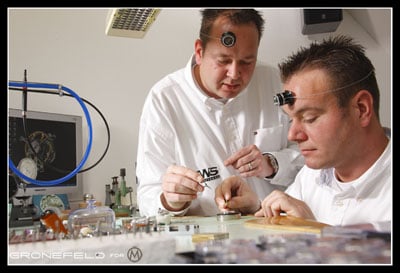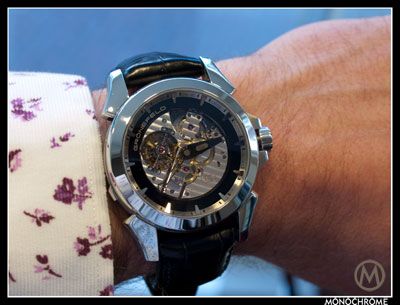Interview with Tim and Bart Grönefeld

Last month Tim and Bart Grönefeld launched the Grönefeld One Hertz, a unique wristwatch with an independent deadbeat seconds, also known as seconde morte. Monochrome interviewed Tim and Bart to find out more about these two watchmakers and their two complicated watches.
The One Hertz is the second watch from the two brothers from the Netherlands, both highly skilled watchmakers. Their first watch, launched in 2008, was the extremely complicated GTM-06 featuring a tourbillon and a minute repeater with cathedral gongs.

Fine watchmaking is a family tradition as both Tim and Bart are 3rd generation watchmakers, following their father and grandfather. The Grönefeld watchmaker dynasty began in 1912, when grandfather Johan Grönefeld began his career as a watchmaker.
When the Grönefeld GTM-06 was released, to some it was a surprise that two relatively unknown watchmakers from the Netherlands could develop such a highly complicated wristwatch. However, Tim and Bart were well known to insiders and have been working on the most complicated watches for many years.

Tim and Bart have a very impressive resume. After extensive training in Switzerland, within a relatively short time span they proved themselves specialists in the production of the most coveted and exquisite horological complications of all: the tourbillon and the minute repeater wristwatch.
This year Tim and Bart presented their second watch, the One Hertz, which is the world’s first wristwatch with independent deadbeat seconds and features a completely new in-house developed movement.

Now on to the interview…..
Monochrome: Let’s talk about your new watch, the Grönefeld One Hertz. When did you start with the idea to develop your own calibre for a new Grönefeld watch?
Grönefeld: To make a calibre exclusively for ourselves is a dream come true. In 2008 we were assembling our first watch, the GTM-06 tourbillon-minute-repeater, and decided to create a watch that is more affordable to a larger public. That meant that it should not have a complication as sophisticated as the GTM-06. To make a simple time-only watch does not fit our strategy as we are experts on complications. The One Hertz features three complications: independent deadbeat seconds; power reserve; and a special push setting-winding mechanism.
Monochrome: How long did it take to create the new caliber and the new watch?
Grönefeld: The development began when we started sketching designs at the beginning of 2009. We were very happy to develop our ideas in collaboration with Renaud et Papi and we have been working closely with them for 20 years now. The technical side and the design of the One Hertz is finalized and components are now being manufactured. From first sketches to a finished watch will have taken two years of hard, but interesting and satisfying work.
Monochrome: What did you learn from your previous watch, the Grönefeld GTM-06, that was incorporated in the One Hertz?
Grönefeld:The design of the GTM-06 is very masculine and we wanted some of that design DNA in the One Hertz. However we have made the watch more elegant by using finer lugs and a thinner bezel. The shape of the indexes mounted on a black ring is similar to the GTM-06, but the dial of the One Hertz is subtler because the movement is only visible from the back whereas you could see the top of the movement on the GTM-06.
Monochrome: What challenges did you encounter designing a brand new calibre from scratch?
Grönefeld: We have been now working for 20 years on the most complicated watches in the world. To make a relative simple complicated movement is not really that difficult for us. Especially as we have the experience and collaboration of Renaud et Papi, with whom we have a very strong relationship. We make a great team.
Monochrome: You chose a calibre with deadbeat seconds, which is a complication not seen often. Why did you choose this complication? And how did you come up with the independent force for this extremely rare complication.
Grönefeld: Luxury wristwatches are mostly in demand for the emotion they offer. They are hand made with passion and patience. In the era when quartz watches came out the deadbeat seconds mechanism in a mechanical wristwatch was simply “not done” because the second hand moved like a quartz second hand. In the 1800’s quite a few independent deadbeat second pocket watches were made, indicating to their owner that they possessed a high quality accurate timekeeper. The highest quality regulator wall clocks had also deadbeat seconds. Because the second hand jumps in full one-second increments like quartz seconds, it is a very discrete watch. Unless the movement is viewed from the back, only the owner knows what beats inside the One Hertz.
Monochrome: The One Hertz features similar design elements as the GTM-06, e.g. the lugs, crown and probably the most important, it’s looks and style. What was your role in the design of both watches?
Grönefeld: All of the design of both of our watches was created by us, though with the One Hertz we also benefited from the input of a very experienced designer. Since the launch of the One Hertz we have had extremely positive feedback regarding its design.
Monochrome: Is the One Hertz, the way it’s presented to the press, what you imagined before you started?
Grönefeld: We are very happy with the case and dial design. The design of the movement is also important and unique to Grönefeld, the style of the bridges in particular. We only use classical materials such as steel, brass and German silver. For the bridges we have chosen stainless steel. The bridges sit very close to each other so that the hand-bevelling reflects light like a mirror. The centres of the bridges are laser engraved and sandblasted to give a unique look at the movement. At first we thought that we could make the watch with fewer components; however, after making the movement function better and look more interesting, we ended up with a lot of components, approximately 270 in total.
Monochrome: What’s next for Tim and Bart Grönefeld?
Grönefeld: We have a couple of ideas for the future. We do not know yet which complication to chose. Most probably they will be more complicated then the One Hertz. We will follow our “mechanical” heart, though we can reveal that we do love complicated wristwatches.
This interview was also posted at The PuristS Pro.



